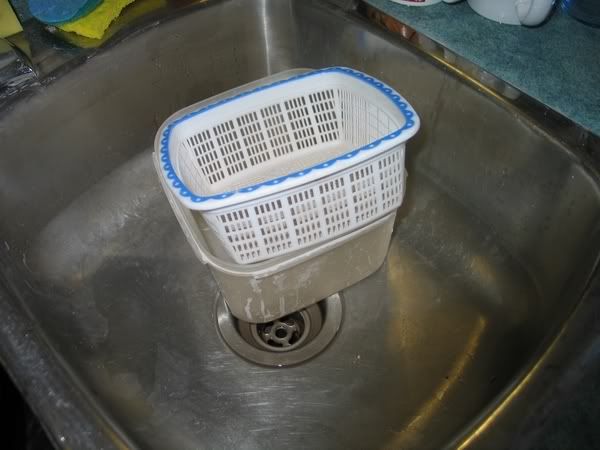Rogue Trader
freely admits to licking rocks
   "Don't cry because you are leaving, smile because you were there."
"Don't cry because you are leaving, smile because you were there."
Member since December 2008
Posts: 839
|
Post by Rogue Trader on Mar 18, 2009 3:56:47 GMT -5
I keep reading all the threads relating to polish, polishes, and polishing. I know we all have our own tried and tested methods, and some of the newer ones are still learning, and quite rightly still asking questions about polish quantities.
I've seen replies ranging from 2tsp to 12tsp per batch of rocks.
Does anyone (apart from myself) re-use their polish mixture?
After polishing the rocks, I filter them out of the polish using a plastic flour strainer, then filter the polish mix through a stocking (not what we over here call a sock,) just incase there are any minute particles of stone breakaway.
Last batch of polish mix I used lasted to over a year. That was made up of only 3tsp of CO. And completed maybe nine polishes with it.
|
|
|
|
Post by Hard Rock Cafe on Mar 18, 2009 7:06:18 GMT -5
I've heard of people doing it, but never a method for capturing the polish. Now that you've given me the idea, I'm trying to figure out how to do it easily with an 18 lb. load.
Chuck
|
|
NDK
Cave Dweller 
Member since January 2009
Posts: 9,440
|
Post by NDK on Mar 18, 2009 12:41:59 GMT -5
I reuse mine, but never thought of small rock pieces being mixed in. I just strain it through a window screen. I actually just reused some for the first time, and was slightly unhappy with the outcome. This may explain a little what may have happened. I'll definately filter it through a stocking ( I believe what are called nylons here lol).
Thanks for the idea!
Nate
|
|
|
|
Post by LCARS on Mar 18, 2009 20:33:31 GMT -5
I reuse all my polishes, I get great results and it saves me some dough (every bit helps).  It's not hard to recover a good 80-90% of your polish and as long as it's uncontaminated it can be used again with almost the same effectiveness as when it was fresh. Most polishes wear out pretty slowly since particles that small can't be physically reduced much more than they already are with the energy densities inside a rock tumbler. When i'm satisfied with the shine I pour my rocks through this rig and pour a bit of water into the barrel then swish it around and pour it over the rocks to rinse most of the residual polish into the basin below the straiuner.  A few pellets will sometimes slip through, meaning they are getting too smal anyway so I skim them off and then i'm left with the polish slurry in suspension and any bits small enough to slip through the holes in the strainer (about 1/16") at the bottom. I will then slowly pour off about 95% of the liquid into a separate ziploc/glad container, being carefull not to let any of the solids settled at the botom reach the edge of the corner i'm using as a pouring spout so what's left is all polish slurry in a separate container and I can now finishing rinsing my rocks in the strainer and ready them up fo a final burnish cycle with little fuss or waste. Depending on the polish types and stone types involved, decanting may take anywhere from 24-72hrs. Over this time the polish and fine rock dust will settle out leaving a layer of clear water on top. This can be poured off almost entirely if done slowly and steadily (so as not to upset the layers), leaving only saturated polish slurry at about twice the concention (or half the fluid volume or even less) as what originally was recovered from the barrel. I'll store the containers of various polish/rock base types with a lid on them and simply dump half of it back into the next polish batch of simillar stone to prevent cross contamination (ie glass slurry with glass - quartz/jasper - agates etc all separate). I use half recovered and half new polish on almost every cycle (i also do this with prepolish) and I get just as good of results as if I had used all new compound. In fact, the recycled slurry actually helps to prethicken and cushion the load better as it's starting up. This method is indispensible if you like using Tin Oxide polish which is very effective on many stones but also very expensive compared with Aluminum Oxide. The tin oxide polish I recover actually seems to get BETTER with age where-as the alumninum oxide tends to wear out and starts taking longer to shine after about three uses. This has also worked for me with Cerium Oxide and Chromium Dioxide polish, never tried tripoli though... |
|
agatemaggot
Cave Dweller 
Member since August 2006
Posts: 2,195
|
Post by agatemaggot on Mar 18, 2009 20:45:56 GMT -5
I use a similar basket arrangement to wash my loads but, I used Hot Glue to fasten fine mesh hardware cloth (screen )over the inside of the basket. Shot the glue right thru the screen onto the plastic basket . Used plastic screen (no rust ) 1/16 th mesh. Nothing gets out of the basket but grit and gunk !
On plastic the Hot-Glue works as well as rivets !
Harley
|
|
rockwolf
noticing nice landscape pebbles
 
Member since November 2008
Posts: 97
|
Post by rockwolf on Mar 20, 2009 6:29:02 GMT -5
Excellent! Would never have thought about recycling polish as didn't think it would be possible! Will give it a go! Going to add a pack of 'pop socks' (mini stockings) to my shopping list now! ;D
|
|